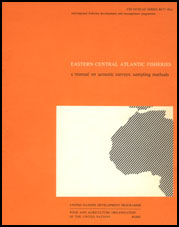
INTERREGIONAL FISHERIES DEVELOPMENT AND MANAGEMENT PROGRAMME - INT/79/019
CECAF/ECAF SERIES 80/17 (En)
FISHERY COMMITTEE FOR THE EASTERN CENTRAL ATLANTIC
Edited by
G.P. Bazigos
FAO-Fishery Resources Officer
Marine Resources Service
Fishery Resources and Environment Division
This manual has been prepared as a result of the Training Course on Acoustic and Trawling Surveys, held at the ISPM Casablanca, on 2-14 June 1980
FOOD AND AGRICULTURE ORGANIZATION OF THE UNITED
NATIONS
UNITED NATIONS DEVELOPMENT PROGRAMME
Rome, 1981
|
The designations employed and the presentation of material in
this publication do not imply the expression of any opinion whatsoever on the
part of the Food and Agriculture Organization of the United Nations concerning
the legal status of any country, territory, city or area or of its authorities,
or concerning the delimitation of its frontiers or boundaries. |
© FAO
This electronic document has been scanned using optical character recognition (OCR) software and careful manual recorrection. Even if the quality of digitalisation is high, the FAO declines all responsibility for any discrepancies that may exist between the present document and its original printed version.
1. PRINCIPLES OF THE USE OF THE SONAR SYSTEM FOR FISH BIOMASS ESTIMATES
1.1 The sonar system
1.2 Time varied gain (T.V.G.)
1.3 Acoustic reflecting properties of fish
1.4 The echo-integrator
1.5 Calibration
1.6 Performance check of equipment
2. PLANNING AND EXECUTION OF ACOUSTIC SURVEY PROGRAMMES
2.1 Main steps involved
2.2 Practical problems arising in obtaining the required information
2.3 Behaviour pattern of fish and its effect on biomass estimates
3. PROBLEMS ARISING IN THE ESTIMATION OF POPULATION TOTALS
3.1 Introduction
3.2 The vertical migratory process (daytime observations)3.2.1. The structure of sample data
3.2.2 De-biasing sample estimates
4.1 Introduction
4.2 The effective sonar range
4.3 Estimating school sizes4.3.1 Estimated school dimensions from sonar traces
4.3.2 Estimation of mean school weight
4.3.3 Estimated PD tolerance limits34.3.3.1 Methodologies used for estimating packing density coefficient (PD)
4.5 Improving the precision of sonar biomass estimates
4.6 Example
5.1 Introduction
5.2 Characteristics of sampling5.3 Estimation of population values
5.3.1 Regular line transect sampling
5.3.2 Random line transect sampling5.4 Construction of error graphs
5.5 Measurement errors in school sizes
5.6 Precision increasing methods
5.7 Rotation system of acoustic surveys
5.8 The accuracy problem of calibration coefficient
6. FACTORS GIVING RISE TO BIAS
6.1 Directed movement of fish with respect to the survey tracks
6.2 Avoidance effect
6.3 Overlapping survey layers
6.4 Shallow water
6.5 Water temperature and the propagation of the sonar beam
6.6 Quality of raw material used
6.7 Accuracy of calibration constant
6.8 Biomass species composition
6.9 The actual accuracy problem of acoustic surveys
7. PROCESSING AND PRESENTATION
7.1 The codification system
7.2 Processing, tabulation, graphical presentation
8. PLOTTING CHARTS OF RELATIVE ABUNDANCE
10. CONCURRENT TRAWLING SURVEYS
10.1 Introduction
10.2 Methods of sampling
10.3 Verification of the counts obtained
10.4 Random sampling10.4.1 Estimated indices
10.4.2 Estimated abundance
10.4.3 The sample size
10.4.4 The logarithmic transformation and the estimation of the confidence limits (small samples)
11. DECK SAMPLING FOR SPECIES COMPOSITION
11.1 Introduction
11.2 Deck sampling methods11.2.1 Direct sampling for proportions
11.2.2 Cluster sampling for proportions
11.2.3 Multi-stage sampling for proportions
APPENDIX I: THE NEGATIVE BINOMIAL DISTRIBUTION
APPENDIX II: FITTING A MATHEMATICAL MODEL TO THE ACOUSTIC DATA OF LAKE TANGANYIKA1